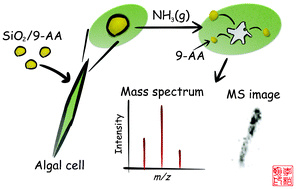A hybrid nanoparticle matrix for mass spectrometry†
Abstract
We demonstrate hybrid inorganic–organic nanoparticles —based on silicon dioxide and 9-aminoacridine— which can enhance mass spectrometric analysis and imaging in the negative-ion mode. The nanoparticles bind to the surface of cells while still in the liquid phase, which is followed by a controlled release of the organic matrix molecules triggered by alkaline ammonia vapours delivered to the specimen in a closed chamber. First, the method was optimized and tested using standard compounds as analytes. Second, the spatial resolution was verified using a natural fibre (diameter ∼20 μm). Third, the method was used in the imaging of molecules present in the outer layer of large algal cells (Closterium acerosum). An important advantage of this method is that nanoparticles loaded with organic matrix can be applied to the biological cells as aqueous suspensions; hence, the release and spreading of metabolites can be limited during sample preparation for MALDI-MS. In addition, since this method does not involve spraying, exposure of experimenters to toxic aerosols is decreased.


 Please wait while we load your content...
Please wait while we load your content...